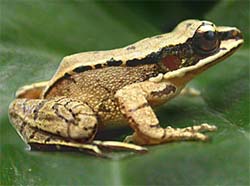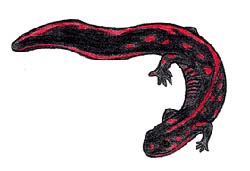

The Yunnan Lake Newt (Cynops wolterstorffi), a species of salamander only found in China, has gone extinct on Earth.
A group of CAS biologists recently lodged an appeal, calling for initiating a national action plan as soon as possible to protect the amphibian species now struggling for their survival throughout the country.
An analysis made by Chinese researchers in 2007 gave a rather blue picture about the overall situation of the amphibians in this country. For instance, the Yunnan Lake Newt (
Cynops wolterstorffi), a species of salamander only found in China, is no longer existing across the globe while some of its cousin Anderson's Salamander (
Echinotriton andersoni) have witnessed a regional disappearance. More than one-fourth of the country's known 365 amphibian species are at the verge of extinction (not including 18% that are data deficient).
Scientists blame the crisis mainly on such factors as habitat loss and degradation, global change, human activities, pollution and over harvesting. One emerging new threat to the species is contagious diseases, note the researchers. The American bullfrog (
Rana catesbiana), a known pathogen carrier, could be found in China's 17 provinces and autonomous regions, posing threat to their ecological safety. In addition, the present protection network for the amphibians fails to cover all endangered species, including some facing imminent extinction, including Chinhai salamander (
Echinotriton chinhaiensis).
The amphibian fauna of China is rather diverse and noted for its high proportion of endemic species so that their protection has an irreplaceable significance and concerned by the international community. However, due to the poor coordination among governmental departments and the lack of effective protection measures, they are marginalized in the conservation drive, according to experts. The investment for their protection is dwarfed by those for "wildlife stars" and the input for the basic research in the field is notably less than other kinds of animals, observe the researchers.
Facing deteriorating situation of the species, CAS scientists call for the rapid initiation of a national action plan for saving the amphibians. While such an effort should be made in line with the global action plan, consideration should be made on its domestic actualities, stresses the experts. They made a proposal on the following five aspects.
1. To upgrade the protection of the major habitats and ecological settings of amphibians. A national program has to be initiated, particularly for the establishment of a protective network covering minimum viable populations of all the threatened species, and for the formulation of a management plan and their enforcement in the existing reserves that are significant for the survival of endangered species at the global level.
2. To enhance sustainable exploitation of the amphibian resources. Programs of public awareness should be launched so as to stop people from making use of the endangered wild amphibian populations. In rural areas, the programs should especially focus on amphibian hunting reduction and in urban regions, the changes of eating habits. Local people should be informed not to collect species that have been endangered by excessive capture. The current list of wildlife under State protection should be revised, adding to it globally endangered amphibians species in China.
Related legal measures have to be strengthened to prevent the excessive catch of the declining populations. Administrations should be improved to ensure that the sustainable harvesting of non-threatened species in the wild. A license system should be further improved so as to guarantee that all produce on the market are from culture farms. In rural areas which depend on unsustainable utilization of frogs, effort should be made to diversify their forms of income raising and protein utilization.
3. To step up scientific research. Efforts should be made to strengthen taxonomic studies and field investigation for discovering new species, as some of them might have be subject to serious threat. In addition, studies should be conducted to understand the jeopardizing process of extinction-causing factors (such as over-catch, diseases, pollution and bio-invasion), so as to develop new methods against them. The detailed exploration and close monitoring of the endangered species worldwide must be also strengthened so that their biological traits and effectiveness of their protective measures are definitely made known to us.
4. To launch a special research program on chytridiomycosis, a newly recognized fungal disease that could causes world-wide catastrophic mortality in amphibian populations, and subsequent extinctions. Efforts should be made to make clear if the current mysterious declines of some endemic species, for instance whited gragon (
Batrachuperus pinchonii), has anything to do with the disease. To achieve this, a special system for its supervision and research should be set up. Studies should be carried out on the management expertise for the breeding of the high-risk species. A mechanism for rapid response to the disease should be put in place, including the capture of infectious species and development of artificial populations. Exploration should be made on management and control over field propagation of the disease and on a compensation mechanism for the amphibian's introduction.
5. To correct the rampant departmentalism and related malpractice in agriculture and forestry administrations in the management of amphibian species. The two governmental departments must have their performance well coordinated.








